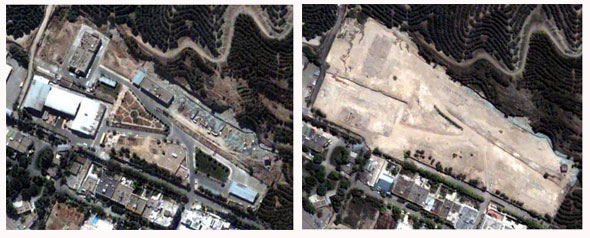
Photos are of the Lavizan-Shian nuclear facility, before a requested International Atomic Energy Agency inspection, and then later when inspectors were allowed access. Images courtesy of DigitalGlobe Quickbird commercial satellite image
Is Iran cooperating with international authorities on the status and extent of its nuclear capabilities? Frank Pabian, project leader for "Rest-of-World" Nuclear Nonproliferation Infrastructure Analysis within International Research, Analysis and Development (N-3) discussed the status of Iran's nuclear cooperation with the international community at a recent talk at the Laboratory.
Titled "Concealment and Deception in Iran: A Pattern for Peaceful Intent?" the talk laid out a pattern of behaviors in Iran that international inspectors have found disturbing, at best. And thanks to remarkable satellite imagery available publicly over the Internet, Pabian was able to provide a stirring, illustrated narrative of the continuing evolution of nuclear technology in Iran.
The talk was a summation of several briefings Pabian has presented on behalf of the United States (for the NNSA and State Department) to the Nuclear Suppliers Group over the past two years on the growing threat from Iran's clandestine nuclear weapons program. It highlighted past Iranian denial and deception attempts to thwart assessment of the extent and progress of that program.
Groups such as the International Atomic Energy Agency (IAEA) have, with the revelation of seven previously unknown nuclear processing sites by an Iranian dissident group, the National Council of Resistance of Iran, been able to show that great effort has gone into enhancing Iran's nuclear fuel cycle capabilities, and in hiding that infrastructure from international scrutiny.
Overall, Pabian said, the story is not a good one.
- An Iranian dissident group first revealed existence of key nuclear related facilities, not Iran;
- Systematic program concealment and deception is corroborated with commercial imagery;
- International Atomic Energy Agency environmental sampling detected enriched uranium, refuting original Iranian declarations of no enrichment and casting more doubt on Iran's peaceful intentions;
- Iran admits to 18 years of NPT safeguards violations; and
- Cover-up tactics on the part of the government and industry continue to improve with time.
In cases where inspectors have requested access to suspect sites, an increasing level of sophistication has gone into the government and nuclear industries' response: In the early days, a facility might merely have had incriminating equipment removed, but inspectors would still find surface samples of uranium and other products.
Later, inspectors found that key sites have undergone considerable modification to inhibit environmental sampling before their visit. Discovering that inspectors were still able to retrieve condemning evidence of nuclear processing, the government, Pabian said, razed an entire facility.
In the case of the Lavizan-Shian Military Physics Research Centre for Nuclear Defense, by June 2004 what had been seen on imagery as a "substantial, secure, engineering-type facility located immediately adjacent to a military, probable aerospace-related, complex located in Lavizan and consisting of three, high-bay, workshop buildings and two multi-story modern laboratory/office buildings, one having a satellite dish on its roof," was reduced to scraped earth, even the topsoil removed, Pabian said.
Under Secretary for Arms Control and International Security John Bolton, in testimony before the House International Relations Committee, Subcommittee on the Middle East and Central Asia, said "Alarm about Iran's nuclear weapons effort has grown at the IAEA over the last year. Since June 2003, the IAEA director general has issued five damaging reports on Iran's failure to adhere to the IAEA safeguards rules it is required to obey pursuant to Article III of the NPT. Every subsequent report contains language confirming that previous Iranian statements made to the IAEA were false or incomplete. The IAEA has repeatedly deplored Iran's deception and lack of cooperation with its inspectors. In response, Iran has defiantly rejected calls by the IAEA and its members to come clean on its nuclear program."
For information, see the IAEA Web site focused on Iran at http://www.iaea.or.at/NewsCenter/Focus/IaeaIran/index.shtml online.
Pabian's talk can be watched on desktop computers by going to http://int.lanl.gov/media/viewall_by_date.php online.
--Nancy Ambrosiano
